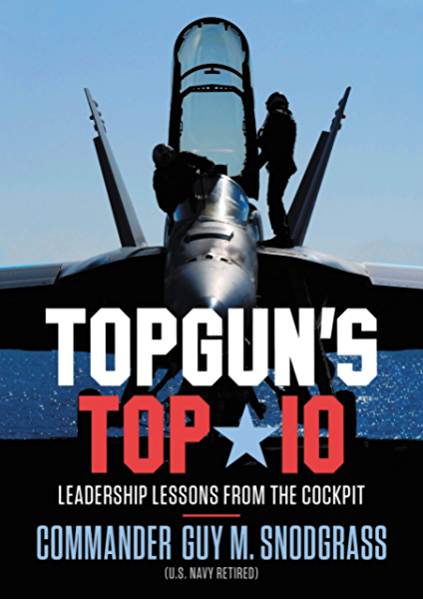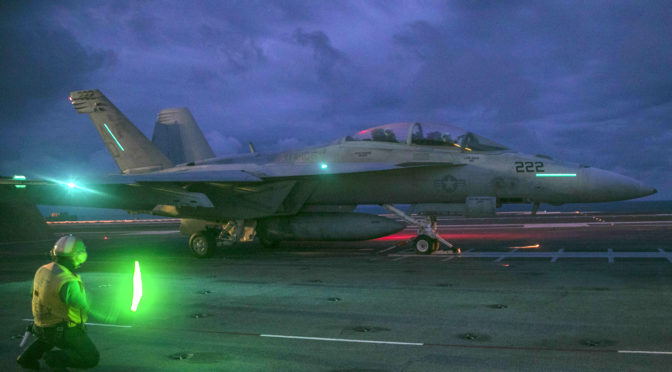Commander Guy M. Snodgrass , TOPGUN’s TOP 10: Leadership Lessons from the Cockpit, Center Street, 2020, $17.99/hardcover.
, TOPGUN’s TOP 10: Leadership Lessons from the Cockpit, Center Street, 2020, $17.99/hardcover.
By Graham Scarbro
The image is an iconic one in American culture: after a long day on the range, a group of cowboys settles in for the night at the campfire. Under a starry sky and over chow, they regale each other with stories of gunfights, lost loves, strange sights and sounds, cantankerous horses, and lessons learned from a life on the plains.
In naval aviation, pilots and flight officers have a similar tradition. Around a wardroom table or in the squadron ready room, aviators gather around one or a group of storytellers and discuss the same topics as their Wild West forebears. Gunfights are replaced with dogfights, and horses with fighter jets, but “cowboy time” is a revered institution in the Navy’s fighter squadrons. Cowboy time can sometimes yield nothing more than an embarrassing story or two, but more frequently it involves valuable lessons and mentorship, true confessions of lessons learned through trial and error (mostly error), and occasional (quixotic) attempts to fix the Navy’s myriad problems.
Out of these discussions may come life lessons, new policies, and even war-winning tactical innovations like the World War II “Thatch Weave,” but most often cowboy time is a way to connect with each other and share experiences with colleagues and friends.
Enter Commander Guy “Bus” Snodgrass, retired, an FA-18 pilot who upended the Beltway apple cart last year with his memoir Holding the Line: Inside Trump’s Pentagon With Secretary Mattis. Bus’s first book (I will address him by his callsign, the mark of respect between aviators for whom first names are reserved for their mothers and friends from high school days) was a solemn pondering of the highest levels of military bureaucracy, a look at the uncertainty surrounding the relationship between Secretary Mattis and the President. When I read the book, I picked up on the subtext of Bus’s writings: the Pentagon was a long way, physically and spiritually, from the cockpit of a fighter jet. Bus alluded to his time in the jet several times in Holding the Line, mostly to contrast it with the Pentagon, and there was the sense that he was straining to make sense of the byzantine world of the “Five Sided Circus” through the lens of decades in the cockpit.
A year later, and the lessons seem to have crystalized for Bus in his newest book, part leadership lesson and part cowboy time. TOPGUN’s Top 10: Leadership Lessons from the Cockpit (“TOPGUN” written as it should be: one word, all caps) represents a return to Bus’s roots in the jet, perhaps a natural consequence of a tumultuous year of self-reflection, following the publication of Holding the Line after an equally unpredictable stint at the Pentagon.
Bus illustrates his top ten leadership lessons with a series of anecdotes that recall nothing more than an evening in the ready room with shipmates. Stories of screwups big and small that, repeated and examined over the years, shape the course of a career and yield the life lessons learned in the fast-paced community that is naval aviation.
The book is a quick read, and Bus’s facility with speechwriting comes through as each leadership lesson only needs a few pages to make the point. This is typical of strike-fighter culture, in which flight briefers have limited time to communicate essential data before taking to the skies to execute the mission. Another aviation staple, the flight debrief, informs Bus’s use of bold-faced, succinct lessons to punctuate each chapter. After a long flight in which a thousand variables yield incalculable discreet results, identifying and examining key takeaways is a prime skill in aviation, used to good effect in the book. Bus follows his own advice to “Put the bottom line up front,” and despite it being the reviewer’s least favorite military aphorism, he uses the technique to good effect, explaining the intended lesson succinctly, illustrating each with a story, and wrapping up the chapter with a quick revisiting of the main point.
True to his title, Bus draws lessons from the everyday world of strike-fighter aviation and avoids an over-reliance on his days as a squadron commanding officer as a source for lofty words of inspiration. A common trope in leadership tomes is to pick stories designed to underscore the writer’s credibility as a commanding officer: the maneuvering of a billion-dollar warship, the ordering of a thousand troops into danger, the left hook into the Iraqi desert, and so on.
Instead of this approach, Bus chooses stories primarily from times when he was not in command, underscoring that leadership is a function of how one acts, and not necessarily the job one holds. This approach was thoroughly refreshing and a marked difference from many military leadership lessons that begin and end with: “Well, when I was in command…” and despite the fact that Bus was by all accounts a successful commanding officer. Bus’s connection of leadership with the daily grind of life in the cockpit as a junior or mid-level officer makes the stories more relatable. A reader can picture him or herself in so many similar situations, whether confronted with small decisions to do the right thing, the need to prioritize the important over the interesting, or being in need of a wingman.
From the personal: “Don’t Wait to Make a Friend Until You Need One,” to the professional: “Don’t Confuse Activity with Progress,” Bus’s advice applies beyond the cockpit to the boardroom, the office, and, ideally, to the Pentagon. Bus eschews complex acronyms and jargon for the sake of explaining in plain voice what he means. The result is understandable prose that remains accessible to all readers.
Readers with aviation backgrounds will recognize the book as a published version of cowboy time in the ready room, although Bus chooses stories that are more chaste and makes the lessons learned more obvious than in a typical aviator’s sea story. TOPGUN’s Top 10 gives readers a glimpse at why the Navy’s TOPGUN culture sets the standard for honest critique, self-reflection, and progress in the face of challenges both external and internal, large and small.
Commander Graham Scarbro is a Naval Flight Officer on active duty. The views expressed here do not represent those of his chain of command, the U.S. Navy, or the Department of Defense.
Featured Image: ATLANTIC OCEAN (Aug. 1, 2020) An F/A-18F Super Hornet attached to the “Gladiators” of Strike Fighter Squadron (VFA) 106 prepares to launch from the flight deck of the aircraft carrier USS Gerald R. Ford (CVN 78) during flight operations, Aug 1, 2020. (U.S. Navy photo by Mass Communication Specialist Seaman Aimee Ford)

